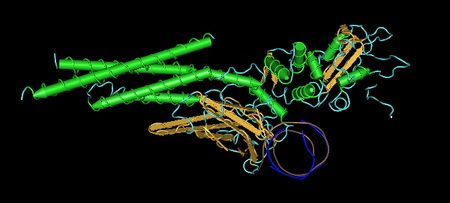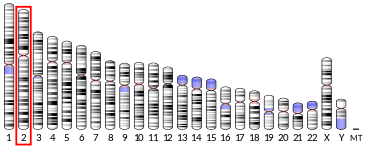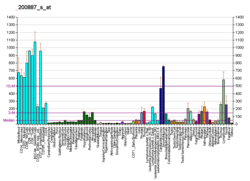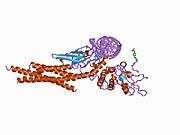STAT1
Signal transducer and activator of transcription 1 (STAT1) is a transcription factor which in humans is encoded by the STAT1 gene. It is a member of the STAT protein family.
Function
All STAT molecules are phosphorylated by receptor associated kinases, that causes activation, dimerization by forming homo- or heterodimers and finally translocate to nucleus to work as transcription factors. Specifically STAT1 can be activated by several ligands such as Interferon alpha (IFNa), Interferon gamma (IFNg), Epidermal Growth Factor (EGF), Platelet Derived Growth Factor (PDGF) or Interleukin 6 (IL-6)[5]
Type I interferons (IFN-a, IFN-b) bind to receptors, cause signaling via kinases, phosphorylate and activate the Jak kinases TYK2 and JAK1 and also STAT1 and STAT2. STAT molecules form dimers and bind to ISGF3G/IRF-9, which is Interferon stimulated gene factor 3 complex with Interferon regulatory Factor 9. This allows STAT1 to enter the nucleus.[6] STAT1 has a key role in many gene expressions that cause survival of the cell, viability or pathogen response. There are two possible transcripts (due to alternative splicing) that encode 2 isoforms of STAT1[7][8]
STAT1 is involved in upregulating genes due to a signal by either type I, type II, or type III interferons. In response to IFN-γ stimulation, STAT1 forms homodimers or heterodimers with STAT3 that bind to the GAS (Interferon-Gamma-Activated Sequence) promoter element; in response to either IFN-α or IFN-β stimulation, STAT1 forms a heterodimer with STAT2 that can bind the ISRE (Interferon-Stimulated Response Element) promoter element.[9] In either case, binding of the promoter element leads to an increased expression of ISG (Interferon-Stimulated Genes).
Expression of STAT1 can be induced with diallyl disulfide, a compound in garlic.[10]
Mutations of STAT1
Mutations in the STAT1 molecule can be gain of function (GOF) or loss of function (LOF). Both of them can cause different phenotypes and symptoms. Recurring common infections are frequent in both GOF and LOF mutations.
Loss of function
STAT1 loss of function, therefore STAT1 deficiency can have many variants. There are two main genetic impairments that can cause response to interferons type I and III. First there can be autosomal recessive partial or even complete deficiency of STAT1. That causes intracellular bacterial diseases or viral infections and impaired IFN a, b, g and IL27 responses are diagnosed. In partial form there can also be found high levels of IFNg in blood serum. When tested from whole blood, monocytes do not respond to BCG and IFNg doses with IL-12 production. In complete recessive form there is a very low response to anti-viral and antimycotical medication. Second, partial STAT1 deficiency can also be an autosomal dominant mutation; phenotypically causing impaired IFNg responses and causing patients to suffer with selective intracellular bacterial diseases (MSMD)[11]
In knock-out mice prepared in the 90s, a low amount of CD4+ and CD25+ regulatory T-cells and almost no IFNa, b and g response was discovered, which lead to parasital, viral and bacterial infections. The very first reported case of STAT1 deficiency in human was an autosomal dominant mutation and patients were showing propensity to mycobacterial infections.[7] Another case reported was about an autosomal recessive form. 2 related patients had a homozygous missense STAT1 mutation which caused impaired splicing, therefore a defect in mature protein. Patients had partially damaged response to both IFNa and IFNg. Scientists now claim that recessive STAT1 deficiency is a new form of primary immunodeficiency and whenever a patient suffers sudden, severe and unexpected bacterial and viral infections, should be considered as potentially STAT1 deficient[12][13]
Gain of function
Gain of function mutation was first discovered in patients with chronic mucocutaneous candidiasis (CMC). This disease is characteristic with its symptoms as persistent infections of the skin, mucosae - oral or genital and nails infections caused by Candida, mostly Candida albicans. CMC may very often result from primary immunodeficiency. Patients with CMC often suffer also with bacterial infections (mostly Staphylococcus aureus), also with infections of the respiratory system and skin. In these patients we can also find viral infections caused mostly by Herpesviridae, that also affect the skin. The mycobacterial infections are often caused by Mycobacterium tuberculosis or environmental bacteria. Very common are also autoimmune symptoms like type 1 diabetes, cytopenia, regression of the thymus or systemic lupus erythematosus. When T-cell deficient, these autoimmune díseases are very common. CMC was also reported as a common symptom in patients with hyper immunoglobulin E syndrome (hyper-IgE) and with autoimmune polyendocrine syndrome type I. There was reported an interleukin 17A role, because of low levels of IL-17A producing T-cells in CMC patients.
With various genomic and genetic methods was discovered, that a heterozygous gain of function mutation of STAT1 is a cause of more than a half CMC cases. This mutation is caused by defect in the coiled-coil domain, domain that binds DNA, N-terminal domain or SH2 domain. Because of this there is increased phosphorylation because of impossible dephosphorylation in nucleus. These processes are dependent on cytokines like interferon alpha or beta, interferon gamma or interleukin 27. As mentioned above, low levels of interleukin 17A were observed, therefore impaired the Th17 polarization of the immune response.
Patients with STAT1 gain of function mutation and CMC poorly or not at all respond to treatment with azole drugs such as Fluconazole, Itraconazole or Posaconazole. Besides common viral and bacterial infections, these patients develop autoimmunities or even carcinomas. It is very complicated to find a treatment because of various symptoms and resistancies, inhibitors of JAK/STAT pathway such as Ruxolitinib are being tested and are a possible choice of treatment for these patients[14][5][15]
Interactions
STAT1 has been shown to interact with:
- BRCA1,[16]
- C-jun,[17]
- CD117,[18]
- CREB-binding protein,[19]
- Calcitriol receptor,[20]
- Epidermal growth factor receptor,[21][22]
- Fanconi anemia, complementation group C,[23][24][25]
- GNB2L1,[26][27]
- IFNAR2,[26][28]
- IRF1,[29]
- ISGF3G[30]
- Interleukin 27 receptor, alpha subunit,[31]
- MCM5,[32][33]
- Mammalian target of rapamycin,[34]
- PIAS1,[35]
- PRKCD,[34]
- PTK2,[36]
- Protein kinase R,[37][38]
- STAT2,[39][40][41]
- STAT3,[22][42][43]
- Src,[21][44] and
- TRADD.[45]
References
- GRCh38: Ensembl release 89: ENSG00000115415 - Ensembl, May 2017
- GRCm38: Ensembl release 89: ENSMUSG00000026104 - Ensembl, May 2017
- "Human PubMed Reference:". National Center for Biotechnology Information, U.S. National Library of Medicine.
- "Mouse PubMed Reference:". National Center for Biotechnology Information, U.S. National Library of Medicine.
- Baris S, Alroqi F, Kiykim A, Karakoc-Aydiner E, Ogulur I, Ozen A, Charbonnier LM, Bakır M, Boztug K, Chatila TA, Barlan IB (October 2016). "Severe Early-Onset Combined Immunodeficiency due to Heterozygous Gain-of-Function Mutations in STAT1". Journal of Clinical Immunology. 36 (7): 641–8. doi:10.1007/s10875-016-0312-3. PMC 5556363. PMID 27379765.
- Database, GeneCards Human Gene. "IRF9 Gene - GeneCards | IRF9 Protein | IRF9 Antibody". www.genecards.org. Retrieved 2017-06-01.
- "STAT1 - Signal transducer and activator of transcription 1-alpha/beta - Homo sapiens (Human) - STAT1 gene & protein". www.uniprot.org. Retrieved 2017-06-01.
- "STAT1 signal transducer and activator of transcription 1 [Homo sapiens (human)] - Gene - NCBI". www.ncbi.nlm.nih.gov. Retrieved 2017-06-01.
- Katze MG, He Y, Gale M (September 2002). "Viruses and interferon: a fight for supremacy". Nature Reviews. Immunology. 2 (9): 675–87. doi:10.1038/nri888. PMID 12209136.
- Lu HF, Yang JS, Lin YT, Tan TW, Ip SW, Li YC, Tsou MF, Chung JG (2007). "Diallyl disulfide induced signal transducer and activator of transcription 1 expression in human colon cancer colo 205 cells using differential display RT-PCR". Cancer Genomics & Proteomics. 4 (2): 93–7. PMID 17804871.
- Rezaei N, Aghamohammadi A, Notarangelo LD (2016-11-30). Primary Immunodeficiency Diseases: Definition, Diagnosis, and Management. Springer. ISBN 9783662529096.
- Chapgier A, Kong XF, Boisson-Dupuis S, Jouanguy E, Averbuch D, Feinberg J, Zhang SY, Bustamante J, Vogt G, Lejeune J, Mayola E, de Beaucoudrey L, Abel L, Engelhard D, Casanova JL (June 2009). "A partial form of recessive STAT1 deficiency in humans". The Journal of Clinical Investigation. 119 (6): 1502–14. doi:10.1172/jci37083. PMC 2689115. PMID 19436109.
- "Defects of STAT1 in Human. Loss of Function exposes to Mycobacteria. Gain of Function exposes to Candida". www.asid.ma-gb. Retrieved 2017-06-01.
- Toubiana J, Okada S, Hiller J, Oleastro M, Lagos Gomez M, Aldave Becerra JC, Ouachée-Chardin M, Fouyssac F, Girisha KM, Etzioni A, Van Montfrans J, Camcioglu Y, Kerns LA, Belohradsky B, Blanche S, Bousfiha A, Rodriguez-Gallego C, Meyts I, Kisand K, Reichenbach J, Renner ED, Rosenzweig S, Grimbacher B, van de Veerdonk FL, Traidl-Hoffmann C, Picard C, Marodi L, Morio T, Kobayashi M, Lilic D, Milner JD, Holland S, Casanova JL, Puel A (June 2016). "Heterozygous STAT1 gain-of-function mutations underlie an unexpectedly broad clinical phenotype". Blood. 127 (25): 3154–64. doi:10.1182/blood-2015-11-679902. PMC 4920021. PMID 27114460.
- Dupuis S, Jouanguy E, Al-Hajjar S, Fieschi C, Al-Mohsen IZ, Al-Jumaah S, Yang K, Chapgier A, Eidenschenk C, Eid P, Al Ghonaium A, Tufenkeji H, Frayha H, Al-Gazlan S, Al-Rayes H, Schreiber RD, Gresser I, Casanova JL (March 2003). "Impaired response to interferon-alpha/beta and lethal viral disease in human STAT1 deficiency". Nature Genetics. 33 (3): 388–91. doi:10.1038/ng1097. PMID 12590259.
- Ouchi T, Lee SW, Ouchi M, Aaronson SA, Horvath CM (May 2000). "Collaboration of signal transducer and activator of transcription 1 (STAT1) and BRCA1 in differential regulation of IFN-gamma target genes". Proceedings of the National Academy of Sciences of the United States of America. 97 (10): 5208–13. doi:10.1073/pnas.080469697. PMC 25807. PMID 10792030.
- Zhang X, Wrzeszczynska MH, Horvath CM, Darnell JE (October 1999). "Interacting regions in Stat3 and c-Jun that participate in cooperative transcriptional activation". Molecular and Cellular Biology. 19 (10): 7138–46. doi:10.1128/MCB.19.10.7138. PMC 84707. PMID 10490649.
- Deberry C, Mou S, Linnekin D (October 1997). "Stat1 associates with c-kit and is activated in response to stem cell factor". The Biochemical Journal. 327 (1): 73–80. doi:10.1042/bj3270073. PMC 1218765. PMID 9355737.
- Zhang JJ, Vinkemeier U, Gu W, Chakravarti D, Horvath CM, Darnell JE (December 1996). "Two contact regions between Stat1 and CBP/p300 in interferon gamma signaling". Proceedings of the National Academy of Sciences of the United States of America. 93 (26): 15092–6. doi:10.1073/pnas.93.26.15092. PMC 26361. PMID 8986769.
- Vidal M, Ramana CV, Dusso AS (April 2002). "Stat1-vitamin D receptor interactions antagonize 1,25-dihydroxyvitamin D transcriptional activity and enhance stat1-mediated transcription". Molecular and Cellular Biology. 22 (8): 2777–87. doi:10.1128/mcb.22.8.2777-2787.2002. PMC 133712. PMID 11909970.
- Olayioye MA, Beuvink I, Horsch K, Daly JM, Hynes NE (June 1999). "ErbB receptor-induced activation of stat transcription factors is mediated by Src tyrosine kinases". The Journal of Biological Chemistry. 274 (24): 17209–18. doi:10.1074/jbc.274.24.17209. PMID 10358079.
- Xia L, Wang L, Chung AS, Ivanov SS, Ling MY, Dragoi AM, Platt A, Gilmer TM, Fu XY, Chin YE (August 2002). "Identification of both positive and negative domains within the epidermal growth factor receptor COOH-terminal region for signal transducer and activator of transcription (STAT) activation". The Journal of Biological Chemistry. 277 (34): 30716–23. doi:10.1074/jbc.M202823200. PMID 12070153.
- Pang Q, Fagerlie S, Christianson TA, Keeble W, Faulkner G, Diaz J, Rathbun RK, Bagby GC (July 2000). "The Fanconi anemia protein FANCC binds to and facilitates the activation of STAT1 by gamma interferon and hematopoietic growth factors". Molecular and Cellular Biology. 20 (13): 4724–35. doi:10.1128/mcb.20.13.4724-4735.2000. PMC 85895. PMID 10848598.
- Reuter TY, Medhurst AL, Waisfisz Q, Zhi Y, Herterich S, Hoehn H, Gross HJ, Joenje H, Hoatlin ME, Mathew CG, Huber PA (October 2003). "Yeast two-hybrid screens imply involvement of Fanconi anemia proteins in transcription regulation, cell signaling, oxidative metabolism, and cellular transport". Experimental Cell Research. 289 (2): 211–21. doi:10.1016/s0014-4827(03)00261-1. PMID 14499622.
- Pang Q, Christianson TA, Keeble W, Diaz J, Faulkner GR, Reifsteck C, Olson S, Bagby GC (September 2001). "The Fanconi anemia complementation group C gene product: structural evidence of multifunctionality". Blood. 98 (5): 1392–401. doi:10.1182/blood.v98.5.1392. PMID 11520787.
- Usacheva A, Smith R, Minshall R, Baida G, Seng S, Croze E, Colamonici O (June 2001). "The WD motif-containing protein receptor for activated protein kinase C (RACK1) is required for recruitment and activation of signal transducer and activator of transcription 1 through the type I interferon receptor". The Journal of Biological Chemistry. 276 (25): 22948–53. doi:10.1074/jbc.M100087200. PMID 11301323.
- Usacheva A, Tian X, Sandoval R, Salvi D, Levy D, Colamonici OR (September 2003). "The WD motif-containing protein RACK-1 functions as a scaffold protein within the type I IFN receptor-signaling complex". Journal of Immunology. 171 (6): 2989–94. doi:10.4049/jimmunol.171.6.2989. PMID 12960323.
- Li X, Leung S, Kerr IM, Stark GR (April 1997). "Functional subdomains of STAT2 required for preassociation with the alpha interferon receptor and for signaling". Molecular and Cellular Biology. 17 (4): 2048–56. doi:10.1128/mcb.17.4.2048. PMC 232052. PMID 9121453.
- Chatterjee-Kishore M, van Den Akker F, Stark GR (July 2000). "Adenovirus E1A down-regulates LMP2 transcription by interfering with the binding of stat1 to IRF1". The Journal of Biological Chemistry. 275 (27): 20406–11. doi:10.1074/jbc.M001861200. PMID 10764778.
- Horvath CM, Stark GR, Kerr IM, Darnell JE (December 1996). "Interactions between STAT and non-STAT proteins in the interferon-stimulated gene factor 3 transcription complex". Molecular and Cellular Biology. 16 (12): 6957–64. doi:10.1128/mcb.16.12.6957. PMC 231699. PMID 8943351.
- Takeda A, Hamano S, Yamanaka A, Hanada T, Ishibashi T, Mak TW, Yoshimura A, Yoshida H (May 2003). "Cutting edge: role of IL-27/WSX-1 signaling for induction of T-bet through activation of STAT1 during initial Th1 commitment". Journal of Immunology. 170 (10): 4886–90. doi:10.4049/jimmunol.170.10.4886. PMID 12734330.
- Zhang JJ, Zhao Y, Chait BT, Lathem WW, Ritzi M, Knippers R, Darnell JE (December 1998). "Ser727-dependent recruitment of MCM5 by Stat1alpha in IFN-gamma-induced transcriptional activation". The EMBO Journal. 17 (23): 6963–71. doi:10.1093/emboj/17.23.6963. PMC 1171044. PMID 9843502.
- DaFonseca CJ, Shu F, Zhang JJ (March 2001). "Identification of two residues in MCM5 critical for the assembly of MCM complexes and Stat1-mediated transcription activation in response to IFN-gamma". Proceedings of the National Academy of Sciences of the United States of America. 98 (6): 3034–9. doi:10.1073/pnas.061487598. PMC 30602. PMID 11248027.
- Kristof AS, Marks-Konczalik J, Billings E, Moss J (September 2003). "Stimulation of signal transducer and activator of transcription-1 (STAT1)-dependent gene transcription by lipopolysaccharide and interferon-gamma is regulated by mammalian target of rapamycin". The Journal of Biological Chemistry. 278 (36): 33637–44. doi:10.1074/jbc.M301053200. PMID 12807916.
- Liao J, Fu Y, Shuai K (May 2000). "Distinct roles of the NH2- and COOH-terminal domains of the protein inhibitor of activated signal transducer and activator of transcription (STAT) 1 (PIAS1) in cytokine-induced PIAS1-Stat1 interaction". Proceedings of the National Academy of Sciences of the United States of America. 97 (10): 5267–72. doi:10.1073/pnas.97.10.5267. PMC 25817. PMID 10805787.
- Xie B, Zhao J, Kitagawa M, Durbin J, Madri JA, Guan JL, Fu XY (June 2001). "Focal adhesion kinase activates Stat1 in integrin-mediated cell migration and adhesion". The Journal of Biological Chemistry. 276 (22): 19512–23. doi:10.1074/jbc.M009063200. PMID 11278462.
- Wong AH, Tam NW, Yang YL, Cuddihy AR, Li S, Kirchhoff S, Hauser H, Decker T, Koromilas AE (March 1997). "Physical association between STAT1 and the interferon-inducible protein kinase PKR and implications for interferon and double-stranded RNA signaling pathways". The EMBO Journal. 16 (6): 1291–304. doi:10.1093/emboj/16.6.1291. PMC 1169727. PMID 9135145.
- Wong AH, Durbin JE, Li S, Dever TE, Decker T, Koromilas AE (April 2001). "Enhanced antiviral and antiproliferative properties of a STAT1 mutant unable to interact with the protein kinase PKR". The Journal of Biological Chemistry. 276 (17): 13727–37. doi:10.1074/jbc.M011240200. PMID 11278865.
- Li X, Leung S, Qureshi S, Darnell JE, Stark GR (March 1996). "Formation of STAT1-STAT2 heterodimers and their role in the activation of IRF-1 gene transcription by interferon-alpha". The Journal of Biological Chemistry. 271 (10): 5790–4. doi:10.1074/jbc.271.10.5790. PMID 8621447.
- Dumler I, Kopmann A, Wagner K, Mayboroda OA, Jerke U, Dietz R, Haller H, Gulba DC (August 1999). "Urokinase induces activation and formation of Stat4 and Stat1-Stat2 complexes in human vascular smooth muscle cells". The Journal of Biological Chemistry. 274 (34): 24059–65. doi:10.1074/jbc.274.34.24059. PMID 10446176.
- Fagerlund R, Mélen K, Kinnunen L, Julkunen I (August 2002). "Arginine/lysine-rich nuclear localization signals mediate interactions between dimeric STATs and importin alpha 5". The Journal of Biological Chemistry. 277 (33): 30072–8. doi:10.1074/jbc.M202943200. PMID 12048190.
- Gunaje JJ, Bhat GJ (October 2001). "Involvement of tyrosine phosphatase PTP1D in the inhibition of interleukin-6-induced Stat3 signaling by alpha-thrombin". Biochemical and Biophysical Research Communications. 288 (1): 252–7. doi:10.1006/bbrc.2001.5759. PMID 11594781.
- Spiekermann K, Biethahn S, Wilde S, Hiddemann W, Alves F (August 2001). "Constitutive activation of STAT transcription factors in acute myelogenous leukemia". European Journal of Haematology. 67 (2): 63–71. doi:10.1034/j.1600-0609.2001.t01-1-00385.x. PMID 11722592.
- Cirri P, Chiarugi P, Marra F, Raugei G, Camici G, Manao G, Ramponi G (October 1997). "c-Src activates both STAT1 and STAT3 in PDGF-stimulated NIH3T3 cells". Biochemical and Biophysical Research Communications. 239 (2): 493–7. doi:10.1006/bbrc.1997.7493. PMID 9344858.
- Wang Y, Wu TR, Cai S, Welte T, Chin YE (July 2000). "Stat1 as a component of tumor necrosis factor alpha receptor 1-TRADD signaling complex to inhibit NF-kappaB activation". Molecular and Cellular Biology. 20 (13): 4505–12. doi:10.1128/mcb.20.13.4505-4512.2000. PMC 85828. PMID 10848577.
Further reading
- Cebulla CM, Miller DM, Sedmak DD (2000). "Viral inhibition of interferon signal transduction". Intervirology. 42 (5–6): 325–30. doi:10.1159/000053968. PMID 10702714.
- Kisseleva T, Bhattacharya S, Braunstein J, Schindler CW (February 2002). "Signaling through the JAK/STAT pathway, recent advances and future challenges". Gene. 285 (1–2): 1–24. doi:10.1016/S0378-1119(02)00398-0. PMID 12039028.
- Joseph AM, Kumar M, Mitra D (January 2005). "Nef: "necessary and enforcing factor" in HIV infection". Current HIV Research. 3 (1): 87–94. doi:10.2174/1570162052773013. PMID 15638726.







